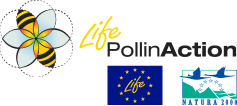Life PollinAction
MONITORING OF THE IMPACT OF THE PROJECT ACTIONS
D.1
Assessment of ecosystem services and design of payment for ecosystem services schemes
What will LIFE PollinAction do: Assessment of ecosystem conditions and their services in the project areas. The action comprises two distinct sub-actions.
- Sub-action D.1.1. aims to monitor the impact of the project on different types of ecosystem services (ES). The assessment methodology is consistent with the EU MAES initiative and with the guidelines provided by the project LIFE+ Making Good Natura. Seven relevant ES have been selected: 1) Regulation and maintenance: Climate regulation, Improvement of soil fertility/quality, Pollination; 2) Provisioning: Agricultural products, Milk, Honey; 3) Cultural: Aesthetic value. The relevance of each ES depends on the typology of intervention site (rural areas/road infrastructures/urban landscapes). The assessment of the ES indicators will be repeated twice, before and after the implementation of the project’s concrete actions (ex-ante and ex-post assessments). This sub-action will focus on the regulating and maintenance ES group, whereas the other will be treated in the sub-action D.1.2.
- Sub-Action D.1.2, aims to economically quantify ES, using methods that allow assigning them a value, and design and implement payment systems for ecosystem services (PES). Payments for environmental/ecosystem services are market-based incentives, often applied to non-market goods. This additional source of monetary income (compensatory mechanism) is intended as an encouragement to provide, and keep providing, environmental/ecosystem services. To assess them, data referring to biophysical conditions will be collected ex ante and ex post, while data concerning the hedonic prices methodologies will be collected through questionnaires which will be distributed only in the ex-post phase, through face-to-face interviews and the focus groups organized within action E3.
Who is responsible for the action: Ca’ Foscari University of Venice
Which partners will collaborate: CITA, FVG, VA
Expected results: Sub-action D.1.1: Quantitative assessment of ecosystem condition and ecosystem service provision in the project areas; quantitative assessment of the nature and extent of improvements brought about by the project interventions;
Sub-action D.1.2: Economic quantification of ecosystem services and development of Payment for Ecosystem Services (PES) schemes; provision of a scientifically sound basis for the design and implementation of financial instruments; provision of data to inform Actions E4 and E5.
When: September 2020 – March 2025
Documents available for download: –
D.2
Ex-ante, ex-post monitoring of actions C
What will LIFE PollinAction do: v
evaluates the contribution of restoration actions to both landscape heterogeneity and pollination networks at the project sites using three different methods:
- recording pollination interactions and describing the structure and robustness of pollination networks;
- assessing the effectiveness of pollination of wild plants based on the frequency of visits by pollinators;
- assessing the effectiveness of pollination of crops based on their productivity
- quantification of the improvement of landscape heterogeneity resulting from the implementation of concrete actions through the comparison of ex ante and ex post detailed mapping of the project sites and calculation of indices that allow to describe and quantify their degree of diversification.
In addition:
- taking advantage of previous LIFE Projects devoted to grassland recreation (specifically LIFE06 NAT/IT/000060 LIFE FRIULI FENS and LIFE10/NAT/IT/243 LIFE MAGREDI GRASSLANDS) which provide us with several grassland communities of different age, the action forecasts the establishment of a chronosequence of pollination interactions to be used as a model system to understand the spatial and temporal dynamics of pollination interaction.
Who is responsible for the action: Ca’ Foscari University of Venice
Which partners will collaborate: CITA, FVG, VA
Expected results: quantitative assessment of the contribution of the creation and/or improvement of habitats for pollinating insects to the increase in plant-pollinator interactions and to the structure and robustness of pollination networks; quantitative assessment of the contribution of restoration measures to landscape heterogeneity; quantitative assessment of the contribution of landscape heterogeneity to plant-pollinator interactions; establishment of a chronosequence of plant-pollinator interactions. Contribute to the definition of the indicators to be developed under the E5 action.
When: September 2020 – March 2025
Documents available for download: –
D.3
KPI indicator reporting
What will LIFE PollinAction do: report on the outputs and impacst of the project through the use of specific Key Project Indicators, with the aim of carrying out a periodic evaluation of the effectiveness of the project throughout its duration and beyond. Data will be provided by D and E actions, and regard the effect of the project on the use of natural resources, sustainable land use, agriculture and forestry, improvement of the natural environment, biodiversity, economic performance, diffusion of products from the dairy and honey supply chain on the market, replication of the project, communication, dissemination and awareness raising related to the project.
Who is responsible for the action: Ca’ Foscari University of Venice
Which partners will collaborate: All the other partners
Expected results: assess the results of the project and its impact.
When: I Quarter 2021, I Quarter 2023, I Quarter 2025
Documents available for download: –

